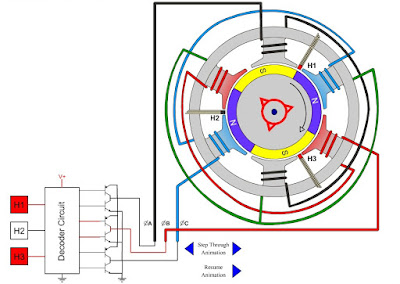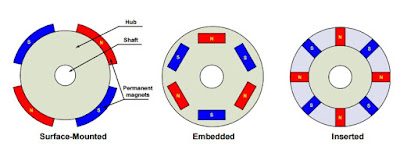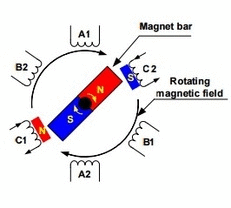What is a Brushless DC or BLDC Motor?
A Brushless DC Motor, BLDC accomplishes commutation electronically using rotor position feedback to determine when to switch the current. The BLDC motor is electrically commutated by power switches instead of brushes. The structure of Brushless DC Motor, BLDC is shown in figure below.
In simple words, a BLDC has no brushes and commutator for having unidirectional torque rather integrated inverter / switching circuit is used to achieve unidirectional torque. That is why these motors are, sometimes, also referred as Electronically Commutated Motors.
Construction of a BLDC Motor:
Like any other electric motor, a BLDC motor also has a stator and a rotor. Here we will consider Stator and Rotor each separately from construction point of view.
BLDC Stator:
There are three types of the BLDC motor:
- Single-phase
- Two-phase
- Three-phase.
Stator for each type has the same number of windings. The single-phase and three-phase motors are the most widely used. The simplified cross section of a single-phase and a three-phase BLDC motor is shown in figure below. The rotor has permanent magnets to form two magnetic pole pairs, and surrounds the stator, which has the windings.
A single-phase motor has one stator winding wound either clockwise or counter-clockwise along each arm of the stator to produce four magnetic poles as shown in above figure.
A three phase BLDC motor has three windings. Each phase turns on sequentially to make the rotor revolve.
Rotor:
A rotor consists of a shaft and a hub with permanent magnets arranged to form between two to eight pole pairs that alternate between north and south poles. Figure below shows cross sections of three kinds of magnets arrangements in a rotor.
How Does A Brushless DC Motor Work?
BLDC Motor operation is based on the attraction or repulsion between magnetic poles. Using the three-phase motor as shown in figure below, the process starts when current flows through one of the three stator windings and generates a magnetic pole that attracts the closest permanent magnet of opposite pole.
The rotor will move if the current shifts to an adjacent winding. Sequentially charging each winding will cause the rotor to follow in a rotating field. The torque in this example depends on the current amplitude and the number of turns on the stator windings, the strength and the size of the permanent magnets, the air gap between the rotor and the windings, and the length of the rotating arm.
Animation for better understanding of BLDC Motor:
Advantage of BLDC Motor:
Compared with a brushed DC motor or an induction motor, the BLDC motor has many advantages:
- Higher efficiency and reliability
- Lower acoustic noise
- Smaller and lighter
- Greater dynamic response
- Better speed versus torque characteristics
- Higher speed range
- Longer life





can single phase make a delta or star?